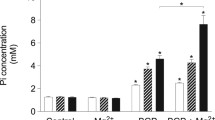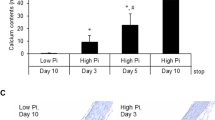Abstract
Lanthanum chloride (LaCl3) has been shown to retard the progression of established atherosclerotic lesions in animal models, and used as a calcium channel blocker in various cellular experiments. In this study, we assessed the role of lanthanum chloride (LaCl3) in H2O2-enhanced calcification in rat calcifying vascular cells (CVCs) and examined the involvement of MAPK signaling pathways. H2O2 induced growth inhibition of CVCs, as well as increases in intracellular levels of calcium and reactive oxygen species, ALP activity, apoptosis and calcium deposition. These effects of H2O2 were suppressed by pretreatment of the cells with 1 μM of LaCl3 for 2 h. In addition, H2O2 activated the phosphorylation of ERK1/2, JNK and p38 MAPK, but only the last two were associated with the ALP activity. Our findings demonstrate that H2O2-enhanced osteoblastic differentiation and apoptosis are responsible for the increased calcification in rat CVCs, and LaCl3 can counteract these effects by suppressing the activation of JNK (JNK2, but not JNK1) and p38 MAPK signaling pathway.








Similar content being viewed by others

Referrences
Bejarano I, Terrón MP, Paredes SD et al (2007) Hydrogen peroxide increases the phagocytic function of human neutrophils by calcium mobilisation. Mol Cell Biochem 296:77–84
Blanc A, Pandey NR, Srivastava AK (2004) Distinct roles of Ca2+, calmodulin, and protein kinase C in H2O2-induced activation of ERK1/2, p38 MAPK, and protein kinase B signaling in vascular smooth muscle cells. Antioxid Redox Signal 6:353–366
Boström K (2001) Insights into the mechanism of vascular calcification. Am J Cardiol 88(Suppl.):20–22
Clempus RE, Griendling KK (2006) Reactive oxygen species signaling in vascular smooth muscle cells. Cardiovasc Res 71:216–225
Dai Y, Li J, Li J et al (2002) Effects of rare earth compounds on growth and apoptosis of leukemic cell lines. In Vitro Cell Dev Biol Anim 38:373–375
Doherty TM (2003) Calcification in atherosclerosis: bone biology and chronic inflammation at the arterial crossroads. Proc Natl Acad Sci USA 100(20):11201–11206
Doherty TM (2004) Molecular, endocrine, and genetic mechanisms of arterial calcification. Endocr Rev 25(4):629–672
Fricker SP (2006) The therapeutic application of lanthanides. Chem Soc Rev 35:524–533
Gillies PJ, Robinson CS, Cockrell BY et al (1989) Effect of lanthanum chloride on established atherosclerosis in the cholesterol-fed rabbit mitral valve as a site for assessment of treatment effects. Arteriosclerosis 9:253–260
Griendling KK, Sorescu D, Lassègue B et al (2000) Modulation of protein kinase activity and gene expression by reactive oxygen species and their role in vascular physiology and pathophysiology. Arterioscler Thromb Vasc Biol 20:2175–2183
Hajnóczky G, Davies E, Madesh M (2003) Calcium signaling and apoptosis. Mol Cell Biol Res Commun 304:445–454
Heffeter P, Jakupec MA, Ko¨rner W et al (2006) Anticancer activity of the lanthanum compound [tris(1, 10-phenanthroline) lanthanum(III)] trithiocyanate (KP772; FFC24). Biochem Pharmacol 71:426–440
Hofer AM, Brown EM (2003) Extracellular calcium sensing and signalling. Nat Rev Mol Cell Biol 4:530–538
Humara M, Loopa T, Schmidt R et al (2007) The mitogen-activated protein kinase p38 regulates activator protein 1 by direct phosphorylation of c-Jun. Int J Biochem Cell Biol 39:2278–2288
Johnson RC, Leopold JA, Loscalzo J (2006) Vascular calcification: pathobiological mechanisms and clinical implications. Circ Res 99:1044–1059
Jono S, Nishizawa Y, Shioi A et al (1997) Parathyroid hormone-related peptide as a local regulator of vascular calcification: its Inhibitory action on in vitro calcification by bovine vascular smooth muscle cells. Arterioscler Thromb Vasc Biol 17:1135–1142
Kefaloyianni E, Gaitanaki C, Beis I (2006) ERK1/2 and p38-MAPK signalling pathways, through MSK1, are involved in NF-κB transactivation during oxidative stress in skeletal myoblasts. Cell Signal 18:2238–2251
Kramsch DM, Aspen AJ, Apstein CS (1980) Suppression of experimental atherosclerosis by the Ca++-antagonist lanthanum. J Clin Invest 65:967–981
Krebs J (1998) The role of calcium in apoptosis. Biometals 11:375–382
Lee DH, Lim B-S, Lee Y-K et al (2006) Effects of hydrogen peroxide (H2O2) on alkaline phosphatase activity and matrix mineralization of odontoblast and osteoblast cell lines. Cell Biol Toxicol 22:39–46
López-Ongil S, Torrecillas G, Pérez-Sala D et al (1999) Mechanism involved in the contraction of endothelial cells by hydrogen peroxide. Free Radic Biol Med 26(5/6):501–510
Mata A, Marques D, Martínez-Burgos MA et al (2008) Magnesium–calcium signalling in rat parotid acinar cells: effects of acetylcholine. Mol Cell Biochem 307:193–207
McConkey DJ, Orrenius S (1997) The role of calcium in the regulation of apoptosis. Biochem Biophys Res Commun 239:357–366
Meloche S, Pouysségur J (2007) The ERK1/2 mitogen-activated protein kinase pathway as a master regulator of the G1- to S-phase transition. Oncogene 26:3227–3239
Mills JS, Johnson JD (1985) Metal ions as allosteric regulators of calmodulin. J Biol Chem 260(28):15100–15105
Mody N, Parhami F, Sarafian TA et al (2001) Oxidative stress modulates osteoblastic differentiation of vascular and bone cells. Free Radic Biol Med 31(4):509–519
Nardello V, Barbillat J, Marko J et al (2003) Lanthanum(III)-catalyzed disproportionation of hydrogen peroxide: a heterogeneous generator of singlet molecular oxygen-1O2 (1Δg)-in near-neutral aqueous and organic media for peroxidation of electron-rich substrates. Chem Eur J 9(2):435–441
Parhami F, Morrow AD, Balucan J et al (1997) Lipid oxidation products have opposite effects on calcifying vascular cell and bone cell differentiation: a possible explanation for the paradox of arterial calcification in osteoporotic patients. Arterioscler Thromb Vasc Biol 17:680–687
Pariente JA, Camello C, Camello PJ et al (2001) Release of calcium from mitochondrial and nonmitochondrial intracellular stores in mouse pancreatic acinar cells by hydrogen peroxide. J Membr Biol 179:27–35
Proudfoot D, Skepper JN, Hegyi L et al (2000) Apoptosis regulates human vascular calcification in vitro: evidence for Initiation of vascular calcification by apoptotic bodies. Circ Res 87:1055–1062
Qin S, Stadtman RE et al (2000) Regulation of oxidative stress-induced calcium release by phosphatidylinositol 3-kinase and Bruton’s tyrosine kinase in B cells. Proc Natl Acad Sci USA 97(13):7118–7123
Ray JL, Leach R, Herbert J-M et al (2002) Isolation of vascular smooth muscle cells from a single murine aorta. Methods Cell Sci 23:185–188
Reynolds JL (2004) Human vascular smooth muscle cells undergo vesicle-mediated calcification in response to changes in extracellular calcium and phosphate concentrations: a potential mechanism for accelerated vascular calcification in ESRD. J Am Soc Nephrol 15:2857–2867
Rojas A, Figueroa H, Re L et al (2006) Oxidative stress at the vascular wall: mechanistic and pharmacological aspects. Arch Med Res 37:436–448
Sato T, Hashizume M, Hotta Y et al (1998) Morphology and proliferation of B16 melanoma cells in the presence of lanthanoid and Al3+ ions. Biometals 11:107–112
Shao J-S, Cai J, Towler DA (2006) Molecular mechanisms of vascular calcification: lessons learned from the aorta. Arterioscler Thromb Vasc Biol 26:1423–1430
Shi P, Huang Z (2005) Proteomic detection of changes in protein synthesis induced by lanthanum in BGC-823 human gastric cancer cells. Biometals 18:89–95
Shioi A, Nishizawa Y, Jono S et al (1995) β-Glycerophosphate accelerates calcification in cultured bovine smooth muscle cells. Arterioscler Thromb Vasc Biol 15:2003–2009
Shorte SL, Schofield JG (1996) The effect of extracellular polyvalent cations on bovine anterior pituitary cells Evidence for a Ca2+-sensing receptor coupled to release of intracellular calcium stores. Cell Calcium 19:43–57
Smajilovic S, Tfelt-Hansen J (2007) Calcium acts as a first messenger through the calcium-sensing receptor in the cardiovascular system. Cardiovasc Res 75:457–467
Smajilovic S, Hansen JL, Christoffersen TEH et al (2006) Extracellular calcium sensing in rat aortic vascular smooth muscle cells. Biochem Biophys Res Commun 348:1215–1223
Su B, Mitra S, Gregg H et al (2001) Redox regulation of vascular smooth muscle cell differentiation. Circ Res 89:39–46
Tabet F, Schiffrin EL, Touyz RM (2005) Mitogen-activated protein kinase activation by hydrogen peroxide is mediated through tyrosine kinase-dependent, protein kinase C-independent pathways in vascular smooth muscle cells: upregulation in spontaneously hypertensive rats. J Hypertens 23:2005–2012
Taniyama Y, Griendling KK (2003) Reactive oxygen species in the vasculature: molecular and cellular mechanisms. Hypertension 42:1075–1081
Touyz RM (2003) Reactive oxygen species in vascular biology: role in arterial hypertension. Expert Rev Cardiovasc Ther 1(1):91–106
Touyz RM, Schiffrin EL (2004) Reactive oxygen species in vascular biology: implications in hypertension. Histochem Cell Biol 122:339–352
Ungvari Z, Wolin MS, Signaling ACAR (2006) Mechanosensitive production of reactive oxygen species in endothelial and smooth muscle cells: role in microvascular remodeling. Antioxid Redox Signal 8(7–8):1121–1129
Vokurkova M, Xu S, Touyz RM (2007) Reactive oxygen species, cell growth, cell cycle progression and vascular remodeling in hypertension. Future Cardiol 3(1):53–56
Wada T (1999) Calcification of vascular smooth muscle cell cultures: inhibition by osteopontin. Circ Res 84:166–178
Wallin R, Wajih N, Greenwood GT et al (2001) Arterial calcification: a review of mechanisms, animal models, and the prospects for therapy. Med Res Rev 21(4):274–301
Watson KE, Bostrom K, Ravindranath R et al (1994) TGF-beta 1 and 25-hydroxycholesterol stimulate osteoblast-like vascular cells to calcify. J Clin Invest 93:2106–2113
Wilkinson JA, Scragg JL, Boyle JP et al (2008) H2O2-stimulated Ca2+ influx via TRPM2 is not the sole determinant of subsequent cell death. Pflugers Arch 455:1141–1151
Zhang J, Jin N, Liu Y et al (1998) Hydrogen peroxide stimulates extracellular signal-regulated protein kinases in pulmonary arterial smooth muscle cells. Am J Respir Cell Mol Biol 19:324–332
Acknowledgments
This study was supported by National Natural Science Foundation of China (Grants 20571006 and 20637010), National Basic Research Program of China (Grant 2007CB516806) and Beijing Talent Project.
Author information
Authors and Affiliations
Corresponding authors
Rights and permissions
About this article
Cite this article
Shi, Y., Gou, BD., Shi, YL. et al. Lanthanum chloride suppresses hydrogen peroxide-enhanced calcification in rat calcifying vascular cells. Biometals 22, 317–327 (2009). https://doi.org/10.1007/s10534-008-9168-1
Received:
Accepted:
Published:
Issue Date:
DOI: https://doi.org/10.1007/s10534-008-9168-1



